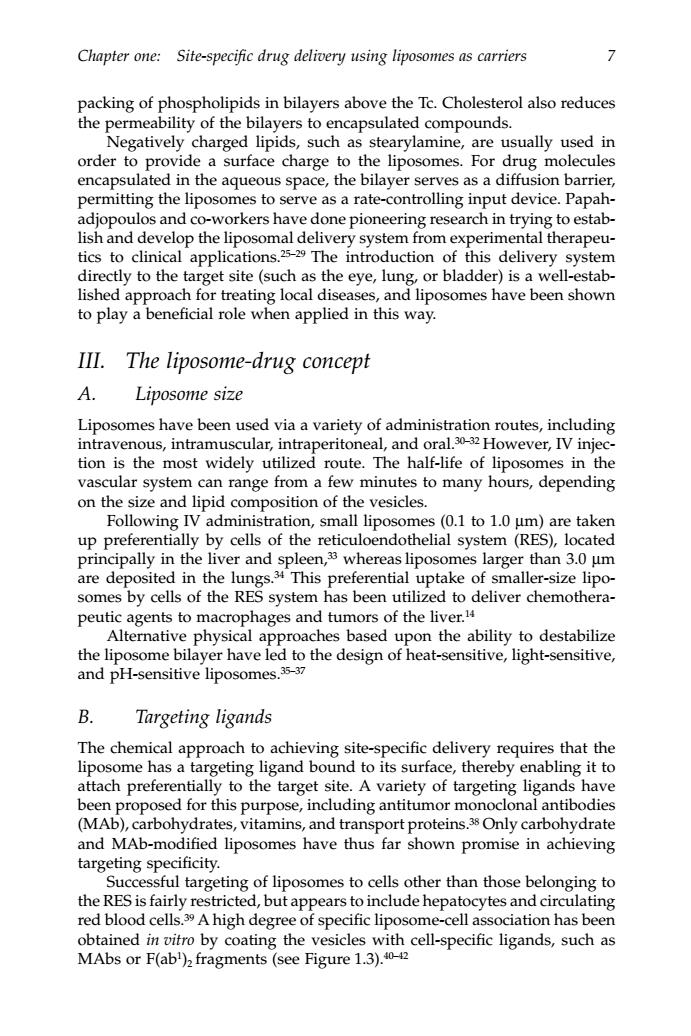正在加载图片...

Chapter one:Site-specific drug delivery using liposomes as carriers 7 packing of phospholipids in bilayers above the Tc.Cholesterol also reduces the of the bilayers ompounds Negatively charged lipids,such as stearylamine,are usually used in order to provide a surface charge to the liposomes.For drug molecules encapsulated in the aqueous space,the bilayer serves as a diffusion barrier permitting the liposomes to serve as a rate-controlling input device.Papah- tics to clinical applicationsThe introduction of this delivery system ery syst directly to the target site(such as the eye,lung,or bladder)is a well-estab- lished approach for treating local diseases,and liposomes have been shown to play a beneficial role when applied in this way. III.The liposome-drug concept Liposome size Liposomes have been used via a variety of administration routes,including intravenous,intramuscular,intraperitoneal,and oral.30-32 However,IV injec- tion is the most widely utilized route.The half-life of liposomes in the vascular system can range from a few minutes to many hours,depending (0.1 to 1.0 um)are taker up preferentially by cells of the reticuloendothelial system (RES),located principally in the liver and spleen,3 whereas liposomes larger than 3.0 um are deposited in the lungs.3 This preferential uptake of smaller-size lipo- somes by cells of the RES system has been utilized to deliver chemothera- peutic acrophages and tumors of the iver. e physical approaches based upon the ability to destabilize the liposome bilayer have led to the design of heat-sensitive,light-sensitive, and pH-sensitive liposomes.35- Targeting ligands chemical approach to achievingeiveryqures that ome hasa .variety of targeting ligand been proposed for this purpose,including antitumor monoclonal antibodies (MAb),carbohydrates,vitamins,and transport proteins.3 Only carbohydrate and MAb-modified liposomes have thus far shown promise in achieving targeting specificity. sful targeting of liposomes to cells other than those belo the RESis fairly re ricted,but appears to incude hepatocytes and n red blood cells.3 A high degree of specific liposome-cell association has been obtained in vitro by coating the vesicles with cell-specific ligands,such as MAbs or F(ab)fragments (see Figure 1.3).40-2Chapter one: Site-specific drug delivery using liposomes as carriers 7 packing of phospholipids in bilayers above the Tc. Cholesterol also reduces the permeability of the bilayers to encapsulated compounds. Negatively charged lipids, such as stearylamine, are usually used in order to provide a surface charge to the liposomes. For drug molecules encapsulated in the aqueous space, the bilayer serves as a diffusion barrier, permitting the liposomes to serve as a rate-controlling input device. Papahadjopoulos and co-workers have done pioneering research in trying to establish and develop the liposomal delivery system from experimental therapeutics to clinical applications.25–29 The introduction of this delivery system directly to the target site (such as the eye, lung, or bladder) is a well-established approach for treating local diseases, and liposomes have been shown to play a beneficial role when applied in this way. III. The liposome-drug concept A. Liposome size Liposomes have been used via a variety of administration routes, including intravenous, intramuscular, intraperitoneal, and oral.30–32 However, IV injection is the most widely utilized route. The half-life of liposomes in the vascular system can range from a few minutes to many hours, depending on the size and lipid composition of the vesicles. Following IV administration, small liposomes (0.1 to 1.0 mm) are taken up preferentially by cells of the reticuloendothelial system (RES), located principally in the liver and spleen,33 whereas liposomes larger than 3.0 mm are deposited in the lungs.34 This preferential uptake of smaller-size liposomes by cells of the RES system has been utilized to deliver chemotherapeutic agents to macrophages and tumors of the liver.14 Alternative physical approaches based upon the ability to destabilize the liposome bilayer have led to the design of heat-sensitive, light-sensitive, and pH-sensitive liposomes.35–37 B. Targeting ligands The chemical approach to achieving site-specific delivery requires that the liposome has a targeting ligand bound to its surface, thereby enabling it to attach preferentially to the target site. A variety of targeting ligands have been proposed for this purpose, including antitumor monoclonal antibodies (MAb), carbohydrates, vitamins, and transport proteins.38 Only carbohydrate and MAb-modified liposomes have thus far shown promise in achieving targeting specificity. Successful targeting of liposomes to cells other than those belonging to the RES is fairly restricted, but appears to include hepatocytes and circulating red blood cells.39 A high degree of specific liposome-cell association has been obtained in vitro by coating the vesicles with cell-specific ligands, such as MAbs or F(ab1)2 fragments (see Figure 1.3).40–42